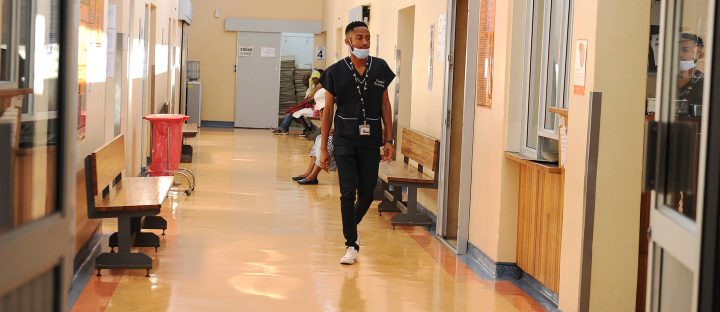SPOTLIGHT
SA’s perennial problems with placing community service doctors continue to frustrate

Troubles regarding the placement of community service doctors have made headlines once again this year, as they seem to do most years. The structural roots of these problems are long-standing and complex. Elna Schütz unpacks the complexities and talks to role-players about possible solutions.
On 8 July 2021, the National Department of Health placed most of the waiting doctors into community service posts after significant pressure from the South African Medical Association (Sama) and others. The pressure included threatening legal action.
One young doctor in this group describes the uncertainty of waiting to be placed, calling the system flawed and saying that it was easy to predict how many interns would need placements by the beginning of the month.
“It really saddens me to think that we’re regarded so poorly and such a scarce skill in our country is just overlooked and that it is acceptable for our colleagues to be working such crazy hours and for us to sit at home. I just don’t see the logic in that.”
Another doctor who was placed last minute says this process has made them consider emigration. “What’s the point of staying in South Africa when our own government doesn’t employ their doctors — especially in a pandemic?”
The system as it should be
To fully qualify and be allowed to practice independently, doctors in South Africa must complete about six years of training, a two-year internship rotating through various sub-disciplines, and then a year of community service, which is also done by 17 other healthcare professions. Internships are generally completed in more centralised or urban centres, while community service is focused more on rural areas.
Placements are supposed to start in January or July. Doctors apply through the Internship and Community Service Programme portal and indicate various preferences such as favoured locations, family status, and medical needs.
Victor Khanyile, director of workforce management at the health department, explains that these decisions are made together with stakeholders such as the national and provincial health and treasury departments and councils like the Health Professions Council of South Africa (HPCSA).
“So, we do annual projections again, where we get the demand,” says Khanyile. In essence, the national department projects the number of posts that will be needed each year, either drawing on numbers by universities, councils, or internship placements and then tries to correlate this with the need and availability of posts in facilities, coordinated by provincial health departments. This match then needs to link to budgets by the Treasury and additional funds must be requested if needed.
It should be noted that some of the experts in the field interviewed by Spotlight had different understandings or misconceptions about how the process works, perhaps indicating that it is not as transparent and clear as it ideally should be.
Doctors waiting
The vast majority of doctors do eventually get these crucial placements, even if it is not in their ideal place or situation.
“It’s a bit of a lucky draw where you end up, sometimes [an] unlucky draw,” says Professor Steve Reid, the director and chair of primary health care at the University of Cape Town. Reid has done over a decade of research into the impact of community service.
First, there is the issue of doctors waiting to be placed. This can happen when doctors finish after January and cannot work until what Khanyile calls the “clean-up cycle” placements in the middle of the year.
Dr Mvuyisi Mzukwa, vice-chairperson of Sama, explains that these delays could be personal, financial, due to the Covid-19 pandemic, or because parts of the training or internship have to be done again. “He says that if they are not taken in, the doctors have to wait another six months.
Doctors may also have to wait or not be placed if there is an unexpectedly larger number than projected. Khanyile gives the example of internship numbers jumping from around 1,200 five years ago to 2,200 this year. “Meaning, there has been at least almost 100% increase in the demand in these posts.” Similarly, he says there was over double the number of mid-year cycle community service doctors needing placement than the projected norm this year.
Dr Tshepile Tlali, acting chairperson of the Junior Doctors’ Association of South Africa (Judasa) says that the doctors that most struggle to be placed tend to be foreign nationals or locals who have studied elsewhere.
“It’s a very terrible way to start your career off,” says Tlali. He says it can cause doctors to lose trust in the system and deal with various psychological challenges. “You also feel very frustrated because at that time you are qualified, but you cannot utilise your skills anywhere.”
A mismatch
This then highlights the second significant problem in the process, which is matching the need or availability of posts with numbers of doctors and particularly funding. The national department can ask the HPCSA to accredit more internship posts, for provinces to make more community service positions open, and then ultimately for National Treasury to provide additional funding to cover these needs in the short term.
But this process takes time and does not always run smoothly. It also needs to take into account that there is enough senior staff, equipment, and need at a facility to make room for the junior placements.
Mzukwa says that there is often a delay in the provinces indicating the numbers of available positions and then matching the appropriate funding. “So now, it becomes a tussle between the provincial departments and the Treasury, and the National Department of Health.”
Treasury budgets are not easily flexible and Reid explains that these are usually historically based and incremental. “I think it’s a fundamental management issue of priorities in terms of a broader HR strategy, and we’ve worked quite hard on that at the national level, but that’s often not carried through to the provincial departments of health.”
Tlali notes that these problems in part stem from an increase in the training of South African doctors after calls and interventions for this several years ago. “Now, the issue is that, with that sharp rise in the number of graduates, there wasn’t adequate preparation to fund those numbers of doctors.”
There are also longer-term issues since the posts are specifically allocated as community service or internship posts. “That after community service, the healthcare system in the country would not accommodate them, because they now have no legal obligation to employ them,” Mzukwa explains. “So you literally have doctors who are sitting at home who are not employed.” Staffing issues at facilities are then also not addressed for the longer term.
Reid adds that the annual turnover of community service doctors also means that it can take several months for young doctors to be fully orientated in their positions which can be taxing on a facility and the care it offers.
Towards solutions
However, there have also been substantial improvements over the last few years. Khanyile says the relatively new Human Resources Capacitation Grant introduced by the health department and funded through the National Treasury helps bridge some gaps.
Tlali says that there had been “a massive breakthrough” in the communications between Judasa and the department and that this made the process smooth for them. However, in the last year, perhaps due to the pandemic, this has not been as efficient again. Tlali says he sees the placements as a key service delivery issue in South Africa and wishes “that could happen without the fighting”.
“I think somebody somewhere in the system is not doing their job,” says Mzukwa. He says that greater collaboration and communication between all the relevant stakeholders, including the HR personnel from provinces, could create change.
The community service placements are part of a bigger picture that requires other supporting strategies and perhaps improved functioning to develop longer-term impact and a better system, particularly for rural areas. Karessa Govender, Programme Manager of Human Resources for Health at the Rural Health Advocacy Project says we need “strengthened health workforce planning at all levels of governance within the Department of Health”.
Adding value
Despite these challenges, these programmes offer significant value. Tlali explains that doctors receive continued practical training while contributing capacity and skills to the wider healthcare system. “You are being tested and you’re giving back to the community.”
“Community service has a clear equity focus and, to date, it is the only intervention that aims to redistribute part of our health workforce to rural areas,” Govender points out. She explains that this is crucial in balancing some of the maldistribution of healthcare workers in the country and providing care to all.
Reid says that, in fact, according to his research, most doctors found that they developed professionally and made a positive contribution. About 80% said this was a really worthwhile experience professionally. “And what was very surprising for us was that the ones who served in the most rural areas were the most satisfied because they felt that they were really contributing significantly to the health of the community that made a difference.” DM/MC
*This article was produced by Spotlight – health journalism in the public interest




















 Become an Insider
Become an Insider
Comments - Please login in order to comment.